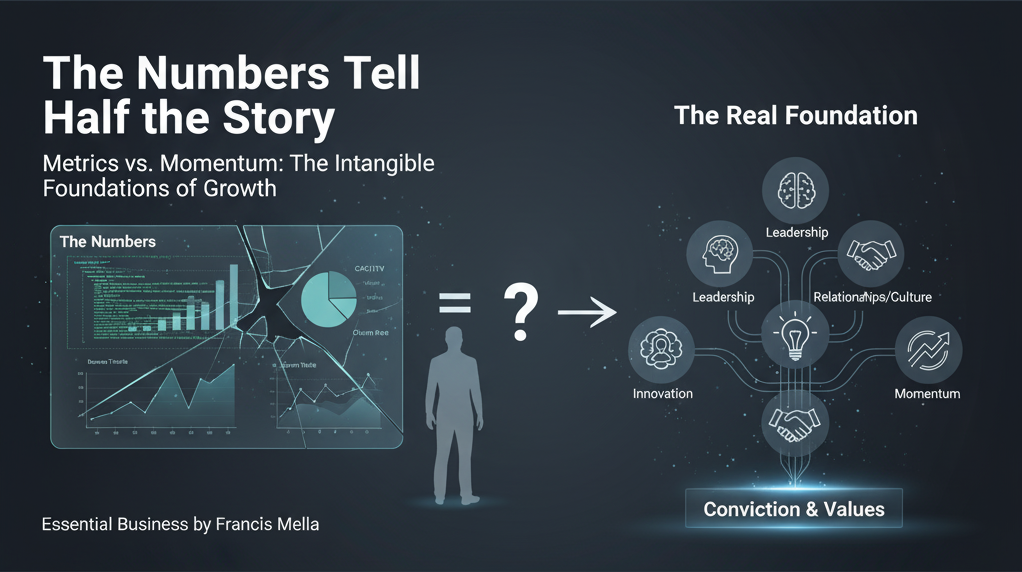
I spent 20 years building B2B brands. Three companies from the ground up.
Every board meeting, every investor call, every quarterly review focused on the same metrics: customer acquisition cost, monthly recurring revenue, customer lifetime value, logo retention, churn rate.
These numbers matter. But they miss something fundamental.
What Metrics Don't Measure
In 1975, physical assets made up 83% of the average S&P 500 company's value. By 2020, things flipped. More than 90% of corporate value now comes from things you can't touch or count easily: brands, relationships, company culture, leadership conviction.
The shift happened, but our measurement systems stayed the same.
U.S. companies lose $550 billion annually from ineffective leadership. Most dashboards don't track this. They also don't track the fact 65% of employees would choose a better boss over a pay raise.2
Your hiring practices stem from leadership conviction. Your product development reflects leadership originality. Your communication strategy reveals leadership clarity.
These elements create momentum long before metrics capture results.
The Momentum Problem
Brand momentum predicts market performance months before financial metrics show distress. Research shows fewer than 1% of brands master sustained growth momentum.3 The ones who do share something beyond strong numbers. They build perceived energy and forward motion.
Momentum comes from decisions you make today about culture, values, and direction. Metrics measure what happened yesterday.
When you focus only on optimizing customer acquisition cost or improving retention rates, you're managing outcomes. The inputs driving those outcomes stay invisible: leadership quality, organizational conviction, strategic clarity.
The Real Foundation
I've watched companies obsess over lifetime value to customer acquisition cost ratios while ignoring fundamental questions about their leadership approach. The ratio looks good on paper, but captures a single moment in time. It doesn't account for how customer behavior changes or how market conditions shift.
For early-stage companies, the concept of "lifetime value" becomes almost meaningless. Your ideal customer profile shifts. Your pricing evolves. Your go-to-market motion adapts. Trying to quantify lifetime value when almost nothing stays fixed creates false precision.
The companies sustaining growth do something different. They build from conviction about who they serve and why they exist. They hire people who share this conviction. They develop products reflecting genuine insight into customer problems.
You won't put these elements in a spreadsheet, but they determine whether your metrics trend up or down six months from now.
What Drives Growth
Business success depends on five intangible qualities: enthusiasm, inspiration, creativity, connectivity, and value alignment. When leadership demonstrates genuine enthusiasm, this spreads through the organization. Employees who feel valued work harder and stay longer.
These factors drive the momentum showing up in your metrics.
Research on organizational success identifies leadership, innovation, company reputation, and employee satisfaction as the most important intangible drivers. They impact results more than many tangible metrics, yet standard performance indicators overlook them completely.
The measurement gap creates a management gap. You optimize what you measure. If you only measure outcomes, you never address the inputs creating sustainable growth.
A Different Approach
I'm not suggesting you ignore metrics. Track your customer acquisition cost. Monitor your churn. Watch your retention rates.
But recognize what those numbers represent: lagging indicators of decisions you made months ago about leadership, culture, and strategic direction.
The companies growing sustainably invest equal energy in the unmeasurable foundations. They ask hard questions about leadership effectiveness. They examine whether their company culture supports innovation. They assess whether their brand builds genuine momentum in the market.
While 78% of HR leaders say behavior change matters most for measuring success, most organizations struggle to track this.6 The difficulty of measurement doesn't reduce its importance. This increases the stakes.
The Real Question
Your metrics tell you where you've been. Your momentum tells you where you're going.
When you built your company, you started with conviction about a problem worth solving. You hired people who shared this vision. You made decisions based on values, not numbers alone.
This foundation created the momentum producing positive metrics.
The question isn't whether traditional metrics matter. They do.
The question is whether your focus on optimizing those metrics has pulled attention away from the leadership qualities, organizational conviction, and strategic clarity creating them in the first place.
If you lose the foundation while chasing the numbers, the numbers follow.

No comments:
Post a Comment